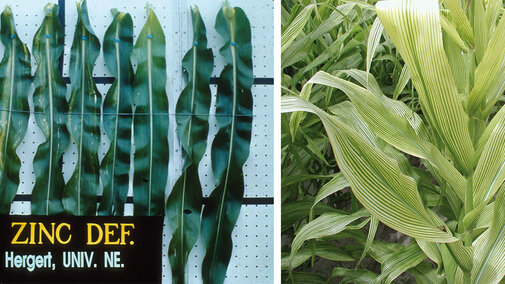A newly revised Nebraska Extension NebGuide, Micronutrient Management in Nebraska, addresses issues of micronutirent fertilizer use with a focus on zinc and iron. It was written by University of Nebraska-Lincoln soils specialists Bijesh Maharjan, Tim M. Shaver, Charles S. Wortmann, Charles A. Shapiro, Richard B. Ferguson, Brian T. Krienke, and Zachary P. Stewart and has been posted to the Extension publications website. The authors wish to thank the Nebraska Corn Board and Winfield® United for providing partial funding for the research cited in this publication.
The NebGuide begins:
"Of the 17 elements known to be essential for plant growth, eight are used in very small amounts and, with the exception of iron, have an uptake of less than 1 pound per acre per year. These elements are classified as micronutrients and include zinc (Zn), iron (Fe), manganese (Mn), copper (Cu), boron (B), molybdenum (Mo), chlorine (Cl), and nickel (Ni). Interest in micronutrients has increased because of accelerated rates of nutrient removal due to greater yields and the availability of alternative micronutrient products.
Micronutrient Availability
Some micronutrients are supplied to plants when weathering breaks down soil minerals over time. However, the greatest supply usually derives from the breakdown (mineralization) of soil organic matter. Soils with low clay and organic matter content are more likely to be deficient in one or more micronutrients. Soils that receive regular manure applications seldom have micronutrient deficiencies.
Nutrient availability is affected by soil pH. The availability of iron and manganese increases with increased acidity (lower pH). Soluble manganese concentrations can be toxic in soil with less than 5.0 pH. Copper, zinc, and boron availability increases with decreased pH until 5.0 to 5.5; below this level availability also decreases. With the exception of molybdenum, micronutrient availability decreases as pH increases above 7.5."
Read more on micronutrient availability, diagnosis of micronutrient problems, crop sensitivity to soil levels, plant sampling, zinc and zinc fertilizers, iron chlorosis, micronutrient toxicities, and more.
This and many more Nebraska Extension publications are available at extensionpublications.unl.edu. Also see this related CropWatch article: What's New with Micronutrients (April 10, 2018).

